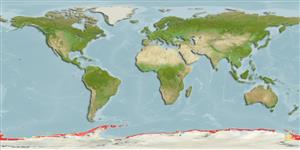Common names from other countries
Environment: milieu / climate zone / depth range / distribution range
Écologie
marin bathydémersal; profondeur 430 - 1120 m. Deep-water; 60°S - 78°S
Southern Ocean: east Antarctica (Davis Sea, Ross Sea, Weddell Sea), South Shetland Islands and South Orkney Islands.
Taille / Poids / Âge
Maturity: Lm ? range ? - ? cm
Max length : 21.0 cm TL mâle / non sexé; (Ref. 5181)
Feeds on isopods, gammaridean amphipods, octopods, polychaetes and mysids.
Life cycle and mating behavior
Maturité | Reproduction | Frai | Œufs | Fécondité | Larves
Eakin, R.R., 1990. Artedidraconidae. p. 332-356. In O. Gon and P.C. Heemstra (eds.) Fishes of the Southern Ocean. J.L.B. Smith Institute of Ichthyology, Grahamstown, South Africa. (Ref. 5181)
Statut dans la liste rouge de l'IUCN (Ref. 130435)
CITES (Ref. 128078)
Not Evaluated
Menace pour l'homme
Harmless
Utilisations par l'homme
Pêcheries: sans intérêt
Plus d'informations
Noms communsSynonymesMétabolismePrédateursÉcotoxicologieReproductionMaturitéFraiFéconditéŒufsDéveloppement de l'œuf
RéférencesAquacultureProfil d'aquacultureSouchesGénétiqueElectrophoresesHéritabilitéPathologiesTraitementMass conversion
CollaborateursImagesStamps, Coins Misc.SonsCiguateraVitesseType de nageSurface branchialeOtolithesCerveauxVision
Outils
Articles particuliers
Télécharger en XML
Sources Internet
Estimates based on models
Preferred temperature (Ref.
115969): -1.6 - 1, mean 0.3 (based on 415 cells).
Phylogenetic diversity index (Ref.
82804): PD
50 = 0.5000 [Uniqueness, from 0.5 = low to 2.0 = high].
Bayesian length-weight: a=0.00661 (0.00383 - 0.01141), b=3.16 (3.00 - 3.32), in cm Total Length, based on LWR estimates for this species & (Sub)family-body (Ref.
93245).
Niveau trophique (Ref.
69278): 3.3 ±0.46 se; based on food items.
Fishing Vulnerability (Ref.
59153): Low vulnerability (11 of 100).
Climate Vulnerability (Ref.
125649): Moderate to high vulnerability (50 of 100).
